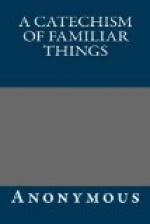What are the Liberal Arts?
The liberal arts are those that are noble and ingenious, or which are worthy of being cultivated without any immediate regard to the pecuniary profit arising from them. They are Poetry, Music, Painting, Sculpture, Architecture, Grammar, Logic, Rhetoric, Astronomy, and Navigation. The arts which relate more especially to the sight and hearing are also called Fine Arts.
Pecuniary, relating to money.
Military, belonging to soldiers, or to arms.
What do the Fine Arts usually include?
All those which are more or less addressed to the sentiment of taste, and whose object is pleasure; these are more especially Music, Painting, Sculpture, and Poetry.
What are the Mechanical Arts?
Those in which the hand and body are more concerned than the mind, and which are chiefly cultivated for the sake of the profit attending them. To this class belong those which furnish us with the necessaries of life, and which are commonly called trades, as carpentry, weaving, printing, &c. There are also many other arts, as the art of writing, &c.
When was the art of Writing invented?
It is supposed that the art was invented before the Deluge: it was certainly practised long before the time of Moses. There were, doubtless, many steps taken in slow succession before the invention of alphabetic writing. Perhaps the earliest method might have been that which is still employed among the untutored tribes of North American Indians, who record events by picture-painting of the rudest description. Picture-painting was afterwards gradually converted into the hieroglyphical system, which is still the only kind of writing among the Chinese. It is not known who invented the alphabetic system of writing.
Deluge, a flood:
the term used in particular to denote
that mighty flood of
water with which God swept away the
first nations of the
earth for their wickedness.
Alphabetic, from alphabet, the series of written signs of language called letters. The word is formed from alpha, beta, the names of the first two letters of the Greek alphabet.
Untutored, ignorant, unlearned.
Were not the Egyptians quite early acquainted with this art?
Yes, they were acquainted with two or three kinds of writing, as well as the one in which symbolical characters were employed, which was not used for common purposes. On the contrary, such symbols had something of a sacred character about them, being unknown to the common people, and only to be deciphered by the priests. Obelisks and pyramids were the great national records; and on these the hieroglyphics were constantly used, because unintelligible to the people, until expounded by those who had the exclusive office of explaining them.
Symbolical, having
the nature of signs or symbols—that
is, representations
of different things.




